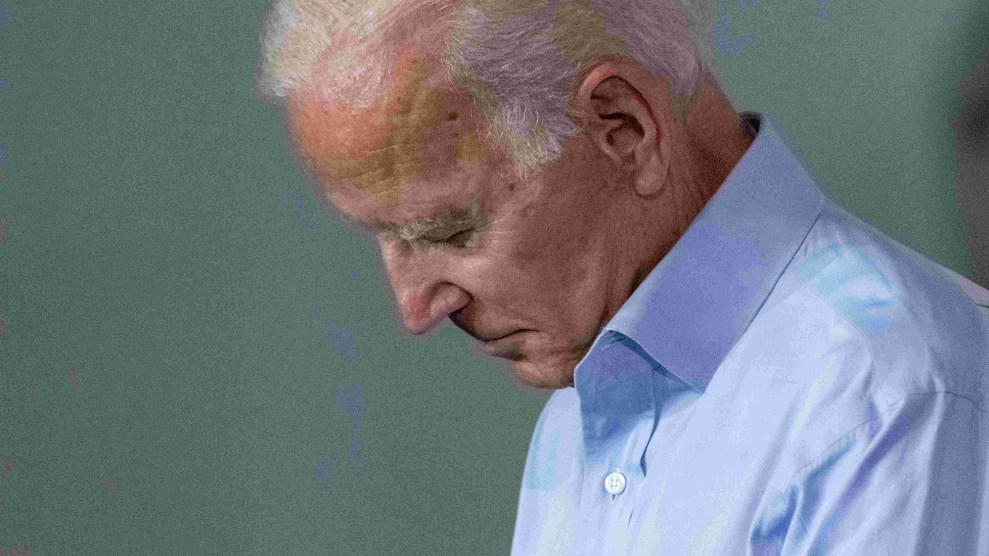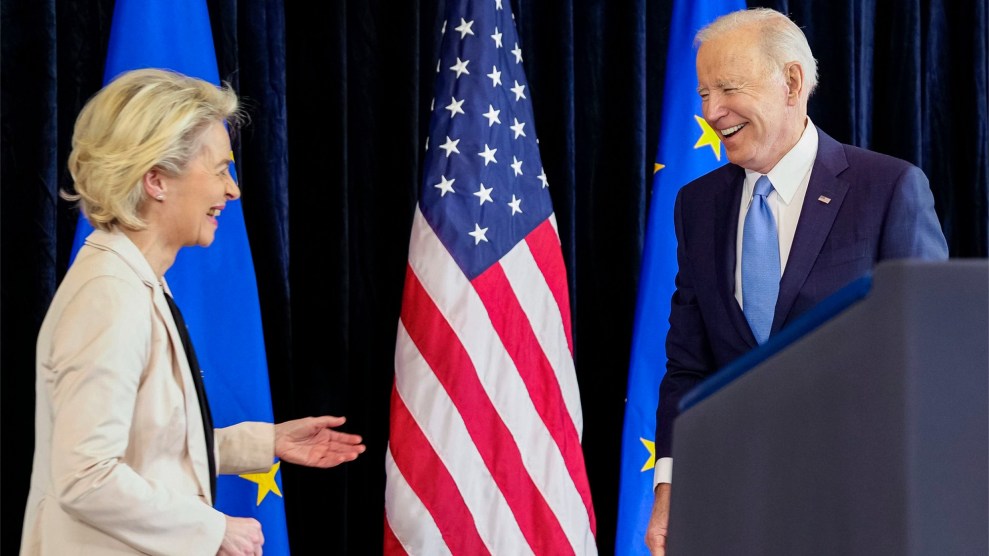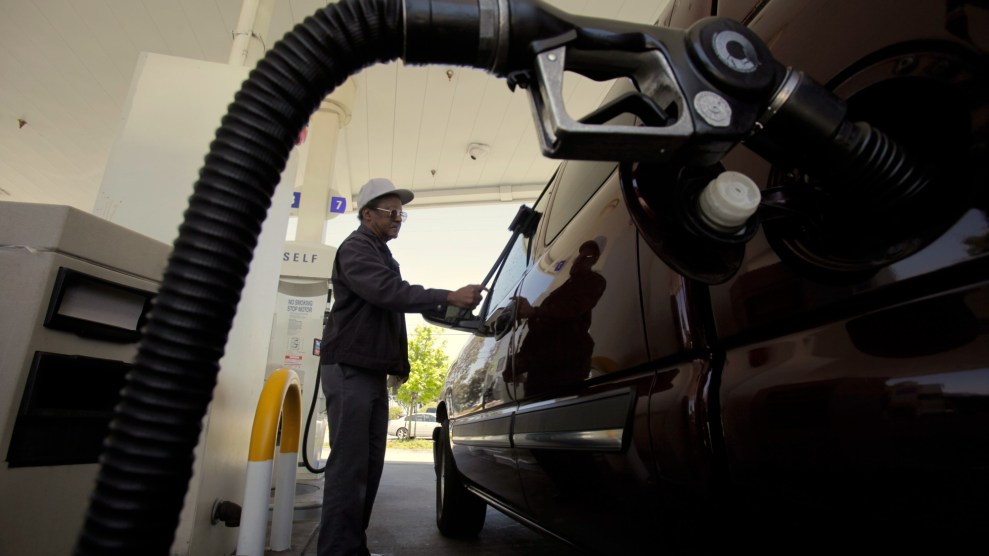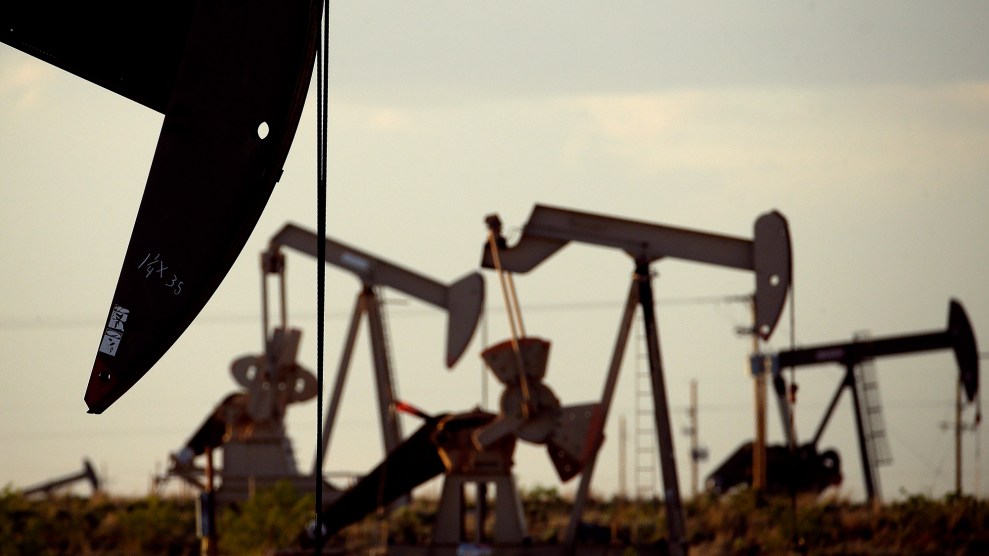
© Richard Ellis/ZUMA Wire
This story was originally published by HuffPost and is reproduced here as part of the Climate Desk collaboration.
Last April, President Joe Biden convened dozens of world leaders for a “virtual climate summit” that sought to generate more ambitious environmental policies ahead of the United Nations Climate Change Conference later in the year. The summit, held on an occasionally glitchy Zoom call, sought to prove that Biden would restore the climate credibility the US had lost under President Donald Trump, and make it a leader in the global fight against catastrophic planetary warming.
Biden has made a series of moves meant to bolster that aim. He returned the US to the 2015 Paris climate accords, pledged to reduce greenhouse gas emissions by half before 2030 and to net-zero by midcentury, and issued numerous executive orders to help achieve those goals.
But 14 months into his presidency and a year since the summit, Biden is facing Russia’s war in Ukraine, rising global oil and gasoline prices, and the intransigence of climate change skeptics both at home and abroad—and they are now threatening to derail his climate agenda altogether.
Since launching his campaign for president, Biden has pledged to make climate change a centerpiece of both his domestic and foreign policy strategies. He would push countries like Brazil, where right-wing President Jair Bolsonaro has presided over record levels of deforestation in the Amazon rainforest, to change course, while simultaneously enacting the most ambitious domestic climate agenda in American history.
His early moves, and promises of further legislative and executive action to come, did succeed in bolstering US climate credibility on the international stage, particularly among major European leaders who had been dismayed by Trump’s withdrawal from the Paris accords, his formation of a convenient anti-climate alliance with Bolsonaro, and the United States’ general turn against any form of aggressive climate action.
“There is a lot more credibility in the way that the US wants to adopt an environmentally friendly policy,” said one European official, who requested anonymity in order to speak freely about the Biden administration’s climate approach. “But there are also some difficulties in the implementation.”
The opening three months of 2022 have shown just how big those difficulties are.
Data released in January showed that US carbon emissions rose sharply last year after a pandemic-driven downturn the year prior, highlighting the struggles Biden may face in curbing emissions overall as the US economy bounces back to life. In early February, West Virginia Sen. Joe Manchin (D) announced his opposition to Biden’s Build Back Better plan, a sweeping legislative proposal that initially included $555 billion in climate-related spending, derailing what would have amounted to the largest package of climate-focused initiatives in US history.
The same month, a surge of deforestation destroyed an area of the Brazilian Amazon rainforest equivalent in size to Washington, DC—a record for the month of February—all while Brazilian lawmakers launched a legislative push that could open even more of the forest to industrialization and destruction.
And in the final week of February, Russia launched an invasion of neighboring Ukraine, sparking a crisis that, beyond its humanitarian implications, has also exacerbated oil supply crunches. In response, Republicans have demanded the US “unleash” domestic fossil fuel production, while some Democrats have begged the Biden administration to abandon efforts to pass climate legislation, fearing it could crater the party’s hopes in looming midterm elections. Last week, Biden ordered the largest-ever release of oil from the nation’s strategic reserves — an average of 1 million barrels per day for six months — to combat high prices and act as a “wartime bridge” until domestic production can ramp up later this year.
The developments have put Biden’s planned international climate agenda in serious jeopardy. “It damages our credibility abroad when you have sweeping campaign promises being made … and then nothing happens,” said Collin Rees, a senior campaigner at Oil Change International, a climate advocacy group. “You can only be the boy who cried wolf so many times on the international stage.”
Brazil has long been at the center of Biden’s desire to make climate a foreign policy focus. During a presidential debate in 2020, he pledged to create a $20 billion international fund to help protect the Brazilian Amazon, and cited rampant destruction of the forest as a key failure of Trump’s foreign policy approach.
But shifting geopolitical circumstances and the right wing’s fervent allegiance to fossil fuels and environmental exploitation have inhibited those plans almost from the beginning.
Early in his presidency, Biden signed a climate-focused executive order that tasked his administration with developing a plan to “promote the protection of the Amazon rainforest and other critical ecosystems that serve as global carbon sinks.” And he sent former Secretary of State John Kerry, who now serves as Biden’s special climate envoy, and other key US officials to Brasília for diplomatic talks meant to persuade the Bolsonaro government to abandon its most destructive policies.
Negotiating better forest protections with Bolsonaro, a climate change denialist who has spent his presidency rolling back regulations and incentivizing deforestation, was always going to prove difficult. But it also offered an opportunity. By bringing Brazil, which had drastically reduced emissions and improved its rainforest protections in the past, back to the table, the US could also prove its own bona fides.
The on-again, off-again negotiations, during which Brazilian officials repeatedly insisted they needed advance payments to protect the forest, eventually resulted in a cursory pledge from the Bolsonaro government to put an end to illegal deforestation by 2028, two years earlier than Brazil had previously said it would.
Throughout the process, Brazilian environmental experts and Indigenous tribes warned the US not to trust Bolsonaro, who they feared would simply legalize deforestation now considered illegal and use any positive outcome—and financial benefit—to bolster his own political prospects.
“The problem in the country is not money, the problem is the government,” said Marcio Astrini, executive secretary of the Climate Observatory, a São Paulo-based environmental organization. “We have the money. We don’t have a government willing to face deforestation.”
Still, the pledge came at a time when it may have seemed possible to “shift Bolsonaro’s focus,” said Mark Langevin, an expert on Brazilian energy and environmental policy at George Mason University in Virginia. He had replaced a hard-line environmental minister with an official many observers had hoped would approach the job more pragmatically. The reputational damage caused by a record outbreak of fires in 2019, and Bolsonaro’s persistent denials that they were even occurring, had also driven some modern elements of Brazil’s influential agribusiness industry to begin pushing the government to change its approach.
Since the agreement, however, Bolsonaro has proceeded the way most environmental experts assumed he would. Brazil’s Congress is already considering a package of legislative proposals favored by Bolsonaro that would allow more large mining projects on protected Indigenous territories in the Amazon and ease regulations over the use of harmful pesticides, The Guardian reported in March. The bills could also lead to another surge in illegal land grabbing, a practice that has helped drive deforestation and violent attacks on Indigenous communities under Bolsonaro, thanks to his government’s lax enforcement of the law and its close ties to garimpeiros—wildcat miners who have scoured the Amazon for its resources.
Even as the forest faces ever-graver threats, Russia’s war appears to have shifted US attention at least for the moment away from deforestation and toward another sensitive environmental topic.
After the invasion of Ukraine, the US placed broad new economic sanctions on Russia, including a ban on the import of all Russian fossil fuels. That has sent domestic gas prices—already on the rise thanks to increased demand at home—to record highs, which could have drastic political ramifications for Biden and the Democratic Party later this year.
In an effort to prevent those increases, the Biden administration has sought to replace lost Russian fuel via other sources, including Brazil. US Energy Secretary Jennifer Granholm urged her Brazilian counterpart, Bento Albuquerque, to boost oil production in a mid-March phone call. Albuquerque immediately agreed, he told Agence France-Presse.
That’s a major priority for Bolsonaro, who has sought to paint the Russian war as “a good opportunity” to loosen environmental protections, boost oil production and ramp up mining on Indigenous territories within the Amazon that are rich in potassium, which could be used to produce fertilizer. (Brazil imports most of its fertilizer from Russia.)
Brazil has plenty of company in seeking to leverage the crisis to bolster domestic industries. Australia and other coal-producing countries are embracing a surge in coal demand as European nations look to replace supplies from Russia. And Biden, who campaigned on a pledge to “take on the fossil fuel industry,” is facing a pressure campaign from that sector and allied Republicans to boost domestic production of oil and gas in order to combat rising energy costs and assist European allies as they seek to reduce reliance on Russian oil.
But the posture toward Bolsonaro demonstrates the ways that Russia’s invasion complicated an already fragile global climate agenda.
“The politics of climate, domestically and internationally, are so challenging,” Langevin said. “And now, all eyes are on Ukraine, which just takes all the oxygen out of the room.”
It has shifted the US posture elsewhere too. Last month, Biden announced plans to boost exports of liquified natural gas to help Europe transition off of Russian gas, which accounts for 40 percent of Europe’s supply. The deal with Europe, the administration argued, would speed the continent’s transition away from dirty energy sources altogether.
“The president knows … that the true path to energy security runs through clean energy, so that’s the second part of this agreement,” a senior administration official said on a call with reporters last month. “The first part is getting Europe off Russian gas. The second part is getting Europe off gas altogether. And he’s committed to reducing our dependence on fossil fuels and reaping the climate, environmental, economic and energy security benefits of moving decisively down that path.”
But it also horrified climate groups in the US, who fear it will lead to a large-scale build-out of gas infrastructure and lock in years if not decades of pollution from what is already one of the key drivers of climate change. Methane, the main component of natural gas, accounts for one-third of all human-caused planetary warming. The fossil fuel industry, by contrast, applauded the move.
This is the fine line the White House has walked both domestically and internationally: On the one hand, it has repeatedly stressed that Russia’s war is a reminder that the US must speed up its transition to renewable energies in order to break free of a global oil and gas market that empowers bad actors and determines prices at home and abroad.
On the other, it has responded to the Republican misinformation campaign about Biden being “at war with” fossil fuels by arguing that the administration has given the industry the tools it needs to increase domestic production. In a speech announcing a US ban on imports of Russian fossil fuels, Biden noted that US oil and gas companies pumped more during his first year than during Trump’s, that production is forecast to reach a record high in 2023, and that the industry has stockpiled more than 9,000 unused but approved permits to drill across millions of acres of federal lands.
“It’s simply not true that my administration or policies are holding back domestic energy production,” Biden said.
The administration is pointing the finger at US drillers for high prices at the pump, even accusing them of profiteering, while simultaneously trying to appease the industry. Granholm has called on producers to “rise to meet current demand” amid Russia’s invasion. And speaking to a room full of energy industry executives at the CERAWeek conference in Houston last month, Kerry said the Biden administration is committed to an “all of the above” future energy policy.
It’s a pro-everything strategy that both Democrats and Republicans have championed for more than two decades, but that is increasingly out of sync with climate science. A report last month concluded that the US and other wealthy, heavy-polluting nations must phase out oil and gas production altogether by 2034 if the world is to have a 50 percent chance of limiting planetary warming to 1.5 degrees Celsius above pre-industrial levels, the goal of the landmark Paris climate agreement.
António Guterres, the secretary-general of the United Nations, recently warned that the war and ensuing pursuit of “all-of-the-above” energy could be the death knell for limiting planetary warming to 1.5 degrees.
“Countries could become so consumed by the immediate fossil fuel supply gap that they neglect or kneecap policies to cut fossil fuel use,” he said. “Addiction to fossil fuels is mutually assured destruction.”
A White House spokesperson said Biden has not wavered in his push for climate action, but said in the short term energy supply must keep up with demand.
“We believe we can walk and chew gum—address supply in the short term because families need to take their kids to school, and go to work, get groceries and go about their lives—and often that requires gas,” the spokesperson said. “But in the long term we must speed up—not slow down—our transition to a clean energy future.”
The State Department did not respond to HuffPost’s request for comment.
Along with ordering a massive draw on the nation’s oil reserves last week, Biden called on Congress to require oil and gas companies to pay fees on idle wells and unused federal leases, as well as pass his stalled Build Back Better climate and social spending package.
Early in his presidency, Biden said the US would push the world forward on climate action in large part through leading by example. It couldn’t ask other countries to meet goals or take aggressive actions if it wasn’t willing to meet the moment itself. But the consensus among climate experts and advocates appears to be that while the Biden administration is talking the talk, it is not yet walking the walk — that the rhetoric has not translated into the aggressive policies that scientists say are required to, in the words of the United Nations’ most recent climate report, “secure a livable and sustainable future for all.”
Even before Russia’s invasion, US climate groups were disappointed in Biden’s ability to deliver at home. Greenpeace USA, a major environmental organization, gave his first year in office a failing grade on its running scorecard of Biden’s climate actions. The Build Back Better plan and its ambitious climate spending were the administration’s chief legislative vehicle to achieve many of its goals. But its future, as a climate plan or as any plan at all, was in doubt even before the invasion inspired Democratic skittishness about the political impact of rising gas prices and GOP calls to expand domestic oil and gas production.
Biden has also come under fire from forest experts. Along with advancing several planned logging projects in mature, carbon-rich forests in the Pacific Northwest, the administration in November released a long-term strategy for slashing emissions that appeared to float cutting down old-growth trees and replacing them with younger stands as a solution to climate change and climate-fueled wildfires. Dozens of climate and public land advocacy organizations have since launched a national campaign to pressure Biden to enact rules to conserve remaining mature forests across the federal estate.
John Noël, a senior climate campaigner at Greenpeace USA, said it’s been “disorienting” to watch fossil fuel permitting and production increase under Biden’s watch after the president described climate change an “existential threat.”
“The overall mood is pissed, straight up,” Noël said. “It’s totally unacceptable.”
Greenpeace USA is among more than 200 climate, social justice and progressive groups that sent Biden a letter last month urging him to “resist short-sighted policies such as scaling up domestic fossil fuel production” and instead to use his executive power, specifically by invoking the Defense Production Act, to speed up America’s transition to clean energy technologies and flight fossil fuel-driven planetary warming. On Thursday, Biden did invoke the Defense Production Act in an effort boost production of critical minerals used in batteries and clean energy technology.
Similarly, the 98-member Congressional Progressive Caucus has called on Biden to take several actions that they argue would allow him to deliver on his campaign promises, including declaring a national climate emergency, reinstating a ban on crude oil exports, prohibiting new oil and gas leases on federal lands and waters, and ending fossil fuel subsidies.
At some point, the Biden administration has to pick a side, said Oil Change International’s Rees.
“This desire to not make anybody mad is going to make everybody mad,” he said. “They need to decide if they are going to be with people or polluters.”
Biden and his team seemingly have as much if not more work to do to prove themselves on the international stage.
Ahead of last year’s COP26 climate summit, Biden pledged to double US climate aid for developing nations from $5.6 billion to $11.4 billion per year by 2024. It was expected to close the gap on the US and other rich nations’ decade-old broken promise of providing $100 billion in climate finance for low-income and vulnerable countries to develop clean energy and adapt to the mounting impacts of climate change.
But when Congress passed its $1.5 trillion spending bill on March 10, less than two weeks after the United Nations’ latest dire climate study, it included a measly $1 billion in international climate aid—less than half of what the White House had requested. (To put that in perspective, the US alone experienced 20 separate billion-dollar climate and weather disasters last year.)
“This is devastating to the politics around climate action because there are so many kinds of initiatives and political developments that need those funds,” said Joseph Curtin, director of The Rockefeller Foundation’s power and climate initiative. “It’s a major impediment to progress.”
On Monday, the White House released its $5.8 trillion federal budget for 2023. While Biden’s statement announcing the request did not mention climate, the proposal calls for $44.9 billion to tackle the crisis, including $11 billion in international climate aid. But the budget request is just that—a request—and the same congressional obstacles that have plagued Biden and his team from the beginning remain.
There is still time for Biden to get things right on climate on the international stage, Curtin said. But with so much attention and resources being directed at the crisis in Eastern Europe, it’s going to require some juggling. In the eight months between now and the COP27 climate summit in Egypt, Curtin said it is critical that Biden and his team shore up financial support for initiatives like Net Zero World, which is aimed at providing technical support for countries looking to accelerate a clean energy transition, and South Africa’s Just Energy Transition Partnership, which seeks to speed up South Africa’s shift away from coal. The US, the European Union, France, Germany and the United Kingdom committed to invest a combined $8.5 billion toward the South Africa initiative.
“I think [climate] is a high priority in the White House,” Curtin said. “But I think it’s taking a little bit of time to crank up the machinery, to deliver on these commitments. Rather than give a very negative grade, I’d prefer to wait and see and assume that the intention is there to deliver on some of these promises.”
“Quite honestly, I can’t see any other way of arriving at COP27.”












